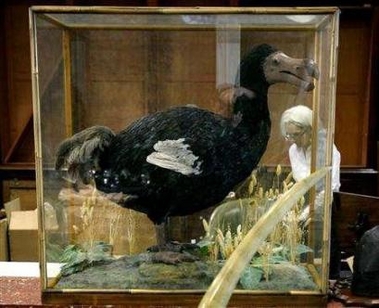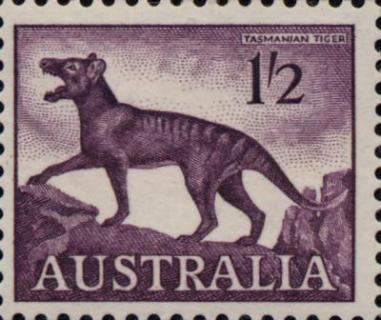Going Dodo Over Tassie Tiger Doodoo and Dodo Bones
Posted by: Loren Coleman on June 30th, 2007

While it is a long shot, there are still people today who report sightings of Dodo birds. Needless to say, even when new fossil remains are found of these avian wonders, the media tends to go a little dodo itself.
Reporter Ed Harris of Reuters learned from Julian Hume, a paleontologist at Britain’s Natural History Museum, of the new discovery of a nearly complete skeleton from a dodo dig on Mauritius, and the news is centering the globe. The new find, Hume shared, is bound to tell more about the elusive bird than perhaps ever known before.
The discovery was made early in June 2007, in the Mauritian highlands but the location was kept secret until the recovery of the skeleton, nicknamed “Fred” (after the 65-year-old man who found the remains) was completed on Friday, June 29, 2007. The site was guarded by four men overnight. This is serious business, safeguarding such remains.
How excited are scientists about this find?
The geneticists who want to get their hands on this will be skipping down the street. Then you can work out how it actually got to Mauritius, because it must have originally flown here before evolving into flightlessness and the big, fat bird that we know. We know it’s a giant pigeon. – Julian Hume, The Natural History Museum, London.
These are the first discovery of dodo remains away from the coastal regions, suggesting that the bird, extinct since the 17th century, lived all over the Indian Ocean island, Hume said. He also added the dodo was almost certainly killed off by animals introduced by Europeans about 400 years ago. Theories that it was hunted to extinction by the Dutch were “total nonsense,” he said, adding that the remains were highly fragile.

If you try and pick it up, it just falls apart. You won’t see a mounted, beautiful thing from this. – Julian Hume, The Natural History Museum, London.
The 2007 recovery was foreshadowed in a June 26, 2006, press release from the British Natural History Museum, about a new discovery at the Mare aux Songes site in Mauritius of dodo fossil leg bones.
Scientists have uncovered many more bones from the dodo, the flightless bird from Mauritius that became extinct in the 1600s. An international research team has been excavating the Mare aux Songes site in Mauritius, the same place rare dodo bones were uncovered in October 2005.
The aim of the expedition is to reconstruct the world of the dodo before Europeans set foot on the island. The material found is up to 3,000 years old and includes a complete articulated dodo leg as well as bones from other animals such as a giant tortoise and other extinct birds.
“The discovery is of huge importance and will give us a new understanding of how dodos lived,'” explained Julian Hume, zoologist at the Natural History Museum and part of the research team. ‘”This is new material and it is absolutely free of human contamination.”
The dodo, Raphus cucullatus , became extinct in the 1600s, only 80 years after Europeans discovered it.
Dodo’s laid their eggs on the ground making it an easy target for introduced predators such as rats and pigs. The new human arrivals hunted the dodo but also helped destroy much of the bird’s habitat, so extinction became inevitable.
Dodo bones have been found before but were removed from their place without recording the immediate surroundings and other bones that may be buried close by. This makes it difficult for scientists to get a full, accurate picture of a complete bird and how it lived.
We know very little about the dodo. Even basic things such as what it ate, why it had such a large hooked bill and how it looked after its young are a mystery.
The new finds will help to piece together the environment the dodo lived in and will help us understand more about how it become extinct. The Natural History Museum, London 2007.

Meanwhile, in Australia, the fecal material of a cryptid, the possible surviving Thylacine, thought extinct in the wild since 1918, is coming under scrutiny. Despite the last death of a thylacine in the Hobart Zoo in 1936, hundreds of sightings have occurred in Australia and some in Tasmania and New Guinea.
Zoologist Jeremy Austin, from Adelaide University’s center for ancient DNA, will lead the project to look at the animal droppings, known as scats, found in the 1950s and 1960s, to find out if they came from the Tasmanian tiger, or thylacine. “Scientists look at droppings for extinct tiger,” Reuters, June 26, 2007.
About Loren Coleman
Loren Coleman is one of the world’s leading cryptozoologists, some say “the” leading living cryptozoologist. Certainly, he is acknowledged as the current living American researcher and writer who has most popularized cryptozoology in the late 20th and early 21st centuries.
Starting his fieldwork and investigations in 1960, after traveling and trekking extensively in pursuit of cryptozoological mysteries, Coleman began writing to share his experiences in 1969. An honorary member of Ivan T. Sanderson’s Society for the Investigation of the Unexplained in the 1970s, Coleman has been bestowed with similar honorary memberships of the North Idaho College Cryptozoology Club in 1983, and in subsequent years, that of the British Columbia Scientific Cryptozoology Club, CryptoSafari International, and other international organizations. He was also a Life Member and Benefactor of the International Society of Cryptozoology (now-defunct).
Loren Coleman’s daily blog, as a member of the Cryptomundo Team, served as an ongoing avenue of communication for the ever-growing body of cryptozoo news from 2005 through 2013. He returned as an infrequent contributor beginning Halloween week of 2015.
Coleman is the founder in 2003, and current director of the International Cryptozoology Museum in Portland, Maine.










Interesting news on the thylacine. Of course, the best that can be hoped for here is evidence that these animals existed into the ’60s, but that gets us closer. This is a cryptid I hold out a lot of hope for. Obviously, it would be possible since it is only recently extinct (in the ’30s), but the pics I’ve seen of supposed sightings have been indistinct or flat out hoaxes. There’s a lot of Australia fairly unpopulated, so fingers crossed. Maybe yowies have domesticated them as pets…
It is sad how mankind can force the extinction of so many creatures. I hope we have learned to protect our very precious wildlife and realize that without them(or the habitats they live in) we would have a very hard time existing ourselves.
On the thylacine, it would be great to get some good news on the scat. We still have a lot to learn when it comes to cryptids.
New Zealand has a very interesting evolutionary history. The animals of New Zealand evolved for millions of years without any mammals among them until settlers introduced them. This was an ecosystem that had developed totally without mammals suddenly faced with a completely alien type of animal. The dodo is a tragic example of how introduced species can overwhelm native species that have developed no defenses against them.
I do disagree a bit with the assertion that introduced animals were the sole culprits, though. In my opinion, humans most certainly had a hand to some extent in the dodo’s extinction. There are accounts of how the native fauna were so fearless of humans, that settlers were able to literally knock some birds right off the branches with sticks. The dodo was probably not exempt from this sort of treatment. It wasn’t only the white settlers either. From what i understand, the early Polynesian settlers of the islands did some damage to the native species as well.
I read in Popular Science, Feb. 2006 issue I believe, that scientists are attempting to clone these 2 animals. The only problem they are having is that the last remains to be found are so old that there is definite degradation of the dna, so gaps have to be filled (sound familiar?). The Dodo is one animal that I do not believe survived the human onslaught. All known reports said that they were without fear of humans, that is the main reason they are extinct, easy food.
Yes, New Zealand is very interesting from an evolutionary standpoint. Since there weren’t any small rodents (other than bats), insects evolved into much larger forms to fill this evolutionary niche. Unfortunately, due to the influx of rodents, cats and other species brought over with men that prey on the weta, as well as habitat destruction, many species of wetas are facing extinction.
Right Turk, I forgot, no mammals except bats. Anyway, it is an ecosystem that was totally unprepared for the ground dwelling species of mammals that were introduced by settlers. It is a good example of introduced species wreaking havoc on a native ecosystem.
Speaking of cloning possibilities, why not the Garefowl? plenty of remains, surviving habitat and good to eat.